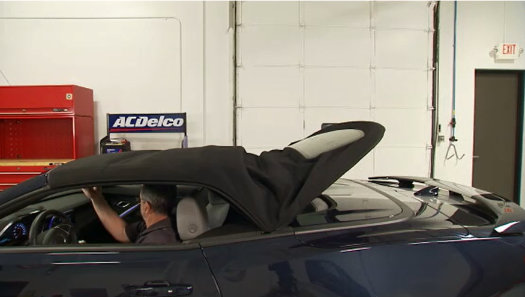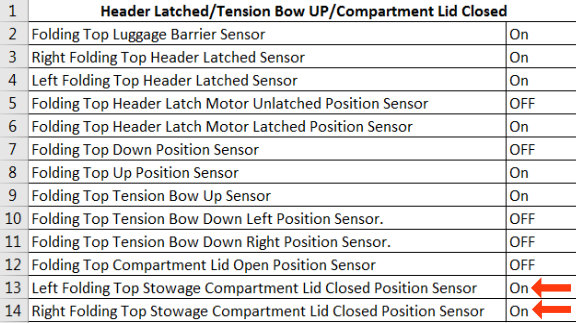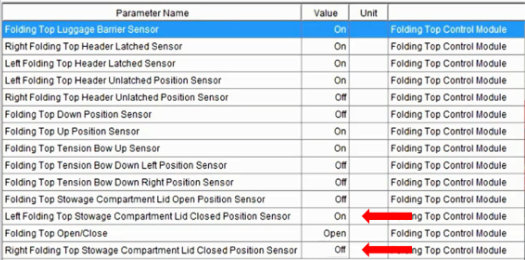2004 - 2009 Cadillac XLR: Service Bulletin: #PIC6378: Diagnosing Various Concerns On A Power Folding Top
Estimated Reading Time: 7 Minutes#PIC6378: Diagnosing Various Concerns On A Power Folding Top - (Dec 17, 2019)
| Subject: | Diagnosing Various Concerns On A Power Folding Top |
|
Brand: |
Model: |
Model Year: |
VIN: |
Engine: |
Transmission: | ||
|---|---|---|---|---|---|---|---|
|
from |
to |
from |
to | ||||
|
Buick |
Cascada |
2016 - 2019 |
All |
All |
All |
All |
|
|
Cadillac |
XLR |
2004 - 2009 |
All |
All |
All |
All |
|
|
Chevrolet |
Camaro |
2011 - 2020 |
All |
All |
All |
All |
|
|
Chevrolet |
Corvette |
2005 - 2019 |
All |
All |
All |
All |
|
|
Pontiac |
G6 |
2005 - 2010 |
All |
All |
All |
All |
|
|
Involved Region or Country |
North America |
|
Additional Options (RPO) |
Power Folding Top |
|
Condition |
Some technicians may have to service a power folding top on one of the vehicles listed above. The concern may be any number of issues related to, but not limited to, the folding top being completely inoperative, the folding top only moves in one direction, or the folding top only partially completes a cycle. Any number of folding top-related DIC messages may be accompanied with the customer’s concern as well. This PIC will provide a general overview / direction on how to begin diagnosing a concern related to the various power folding tops used on GM vehicles. |
|
Cause |
As with all customer concerns, the first step in diagnosing a folding top issue is to fully understand the customer’s description of the concern. In many instances, what the customer describes is not exactly what is found by the technician when he or she inspects the vehicle. Understanding what happened, or what the customer did, right before the concern began, is crucial to correctly diagnosing the folding top. Once the concern or the symptom is understood, the next step is operating the folding top to determine what works, and where does the top stop moving during its cycle. Just because the top operates in one direction, or some functions of the top will work, this does not necessarily mean that the top will operate correctly in the opposite direction. For example, on the Cadillac XLR, the decklid opens as part of the normal folding top opening cycle. In many cases, the rear compartment will open and close correctly all by itself, but it will not operate at all when the folding top is cycled. An important step often overlooked by many technicians in the field is to look for any folding top related messages in the DIC during operation. In many cases, there will be a "Top Not Secure" or a "Only Manual Operation of Top Possible" message displayed. With a "Top Not Secured" message for instance, this indicates that the top is somewhere in the middle of the cycle. It only indicates that the top is not fully closed, nor is it fully open. It simply indicates that it is somewhere in between. By itself, this is not an indication of a fault with the folding top system. The next step in diagnosing a power folding top concern is to check for any DTCs that may have set and follow the applicable flowchart in Service Information. If no codes are found, the next step that must be completed is to follow the applicable folding top sensor matrix. This is essentially a chart of all the various switches and sensors in the folding top system. It tells the technician what each one SHOULD be reading, based on where the top is at in its cycle. With all folding top systems, the top opening or top closing cycle is broken down into a series of small steps, called phases. There can be any number of phases in a complete folding top cycle. A folding top must always complete the first phase before it continues on to the second phase. The folding top must complete the second phase before it continues on to the third phase, and so on. In most cases, the folding top will stop partway through its opening or closing cycle with no DTCs set. This is the most common type of customer concern. This is almost always the result of a sensor or switch that is simply not transitioning its status. If no wiring concern is present, then no DTC will be set, generally speaking. The matrix is used at that point to determine which switch or sensor is not transitioning correctly, and therefore, will require a closer inspection. The matrix for each vehicle can be found in SI. It may be located in Description and Operation, or it may be located in a separate bulletin / PIC. Regardless, this chart is essential to diagnosing a concern within the folding top system. The top must then be operated until the point where it stops moving. Only press and hold the folding top switch one time. Once the top stops moving, do not keep pressing the top switch to try and get the folding top to keep moving. Release the switch and use the scan tool to monitor each one of the folding top position sensors / switches. Run down the matrix to see what each sensor should read, and compare this to the scan tool information for what each sensor is actually reading. At least one parameter should be incorrect. This is the switch or sensor that will require closer inspection. If only one parameter is incorrect, this area will need to be further diagnosed. The tech will need to first determine if this is a mechanical issue or if it is electrical. Determine if the linkage is bent or did the sensor move out of position? Is the sensor’s corresponding magnet missing, or was a wiring fault found? Is the panel simply misaligned? This will at least narrow the concern down to one specific area. Example Case: Let’s take a 2018 Chevrolet Camaro for instance, with a basic folding top concern. The customer states that the top will open fine, but it will not close all the way. A preliminary check will indicate that there is a "Top Not Secure" message in the DIC, but no DTCs are set. The tech is able to duplicate the concern each and every time. When closing, the top will lift up out of the stowage compartment, latch tightly to the windshield header, and the tension bow will lift up to a 45° angle. The Rear Stowage Compartment Lid will lower and lock into position, but the tension bow will not lower. It simply remains suspended in the air as seen in the photo below. The folding top pump quits working and the top stops moving at that point. |

On a correctly working car, the stowage compartment lid must close completely before the tension bow is commanded down. Because the steps or phases must be completed in order, the technician must go to the point where the failure occurs, and then go back one step to look at the scan tool data.
If we look at the Folding Top matrix found in SI, we have the following parameters seen below. This particular vehicle has two separate Stowage Compartment Lid Closed Position Sensors. One is on the left hand linkage and the other is on the right hand linkage. On a working vehicle, both Stowage Compartment Lid Closed Position Sensors should read "On" when the lid is closed.

Looking at the scan tool sensor data below, we can see that only one of the two Stowage Compartment Lid Closed Position Sensors read "On". Because the Folding Top Control Module will not command the tension bow to lower if both Stowage Compartment Lid Closed Position Sensors are not showing that they are closed, the module thinks that the stowage lid is still raised. As a matter of operation, it will not continue the top cycle. In this instance, the technician must further inspect the Right Folding Top Stowage Compartment Lid Closed Position Sensor to determine what the fault is.

|
Version |
1 |
|
Modified |
12/17/2019 — Created on |